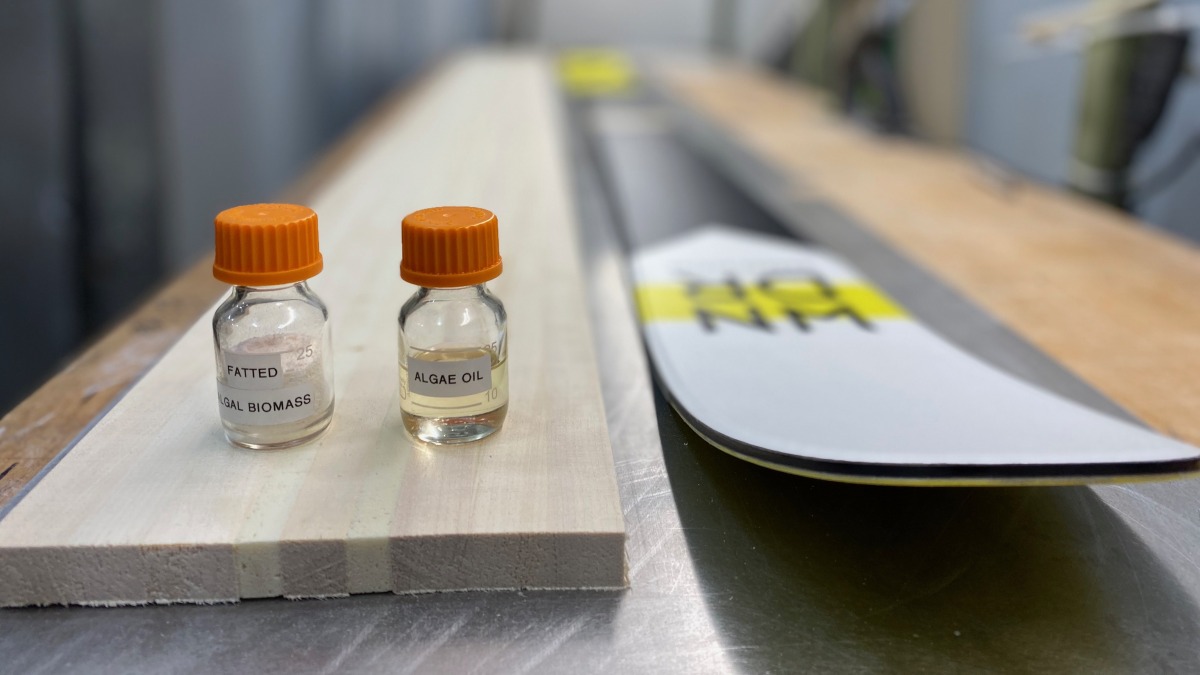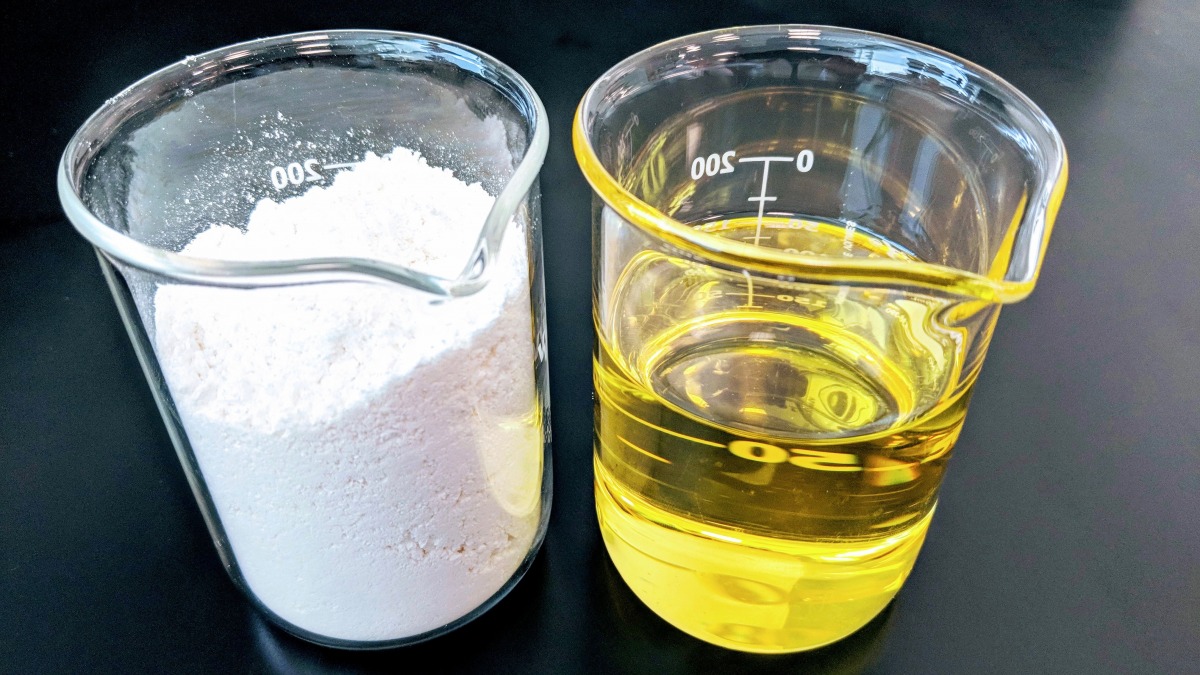This week, we’re taking a look at the greener sides of the ski industry. From plant-based ski products, carbon offsets to easy steps backcountry skiers can take to reduce their own impact, here’s a glass half full take on sustainable innovations and conversations in the ski touring world.
Algae composites make a lightweight ski from the future
My first assignment as the new Gear Editor here at WildSnow was to test out a pair of skis, skis made of… algae? M informed me the manufacturer claimed to be using algal composites tunable specifically for skiing, not just for an idealistic PR gimmick. I immediately envisioned someone scooping a slimy green substance from a laboratory pool and creating something like a stiff Nori that wraps around a wood ski core instead of sushi. This is WildSnow after all, and we’re open to putting new ideas to the test, even sushi skis. I fired eight holes in each ski, filled them with glue, screwed down some bindings, and hit the snow with curiosity abounding.
Lightweight engineered wood cores reinforced with carbon fiber and impossibly thin aluminum derivatives have done wonders for touring ski weights. Some have even ditched wood altogether; the La Sportiva Vapor series kevlar weave comes to mind. These wicked light builds really shine in pure powder, such as the snow pack that graces the hallowed slopes of WildSnow field HQ for most of the winter. Fat skis hitting the 1,200 gram mark allow skiers’ legs an extra lap, or two, or three. These builds do tend to give up a bit of a true grounded feeling, though. And Ullr forbid you encounter some windboard or melt/freeze conditions later in the season. These composite cores go from smooth powder planing vehicles to bucking broncos at the first sign of inconsistency.
Could algae be the key to a more diverse but still lightweight fat ski?
We mentioned Checkerspot in Monday’s eco wax review as a materials company with a skiing habit, tuning eco-friendly materials to better suit ski quality than many petroleum based carbon derivatives. WNDR Alpine, Checkerspot’s ski brand, launched this year with the Intention 110 ski. The cores of the production models are supplemented with a composite derived from algae oil. My aforementioned Nori stringer visions weren’t quite accurate, but we can use another food process to understand the creation of the algae composites — beer anyone? The algae is fermented much like a beer or more accurately, kombucha, inside of stainless tanks devoid of light. No photo synthesis here. The algae is then converted to an oil that is refinable to a multitude of different products.
Chemists out there may note, as Lou did in our meeting with Checkerspot at OR, that this is a very similar process to the natural petroleum life cycle. The difference here is that the roughly 100 million year time span is compressed into weeks. Furthermore, there is much less waste product and carbon released into the atmosphere is a fraction of that created in the process of refining crude oil. Finally, the algae themselves can be coaxed and modified to yield a directly usable product right out of the vats. The buried Mesozoic era plants were what they were, and yield roughly the same oil product no matter where they are pumped from.
The algae composite in the initial production run of Intention 110 is not a stiffening stringer like carbon fiber at all, rather a super light yet sturdy foam laid into the mostly wood cores. This not only provides excellent dampening characteristics, but allows the ski designers to use slightly denser, better skiing wood species like aspen and paulownia while maintaining weights in the balsa range. The result is a light-ish ski without the pingy characteristics of carbon fiber reinforcement (there is zero carbon fiber in the Intention 110). This is not a foam ski either, the composite makes up less than 15% of the total core.
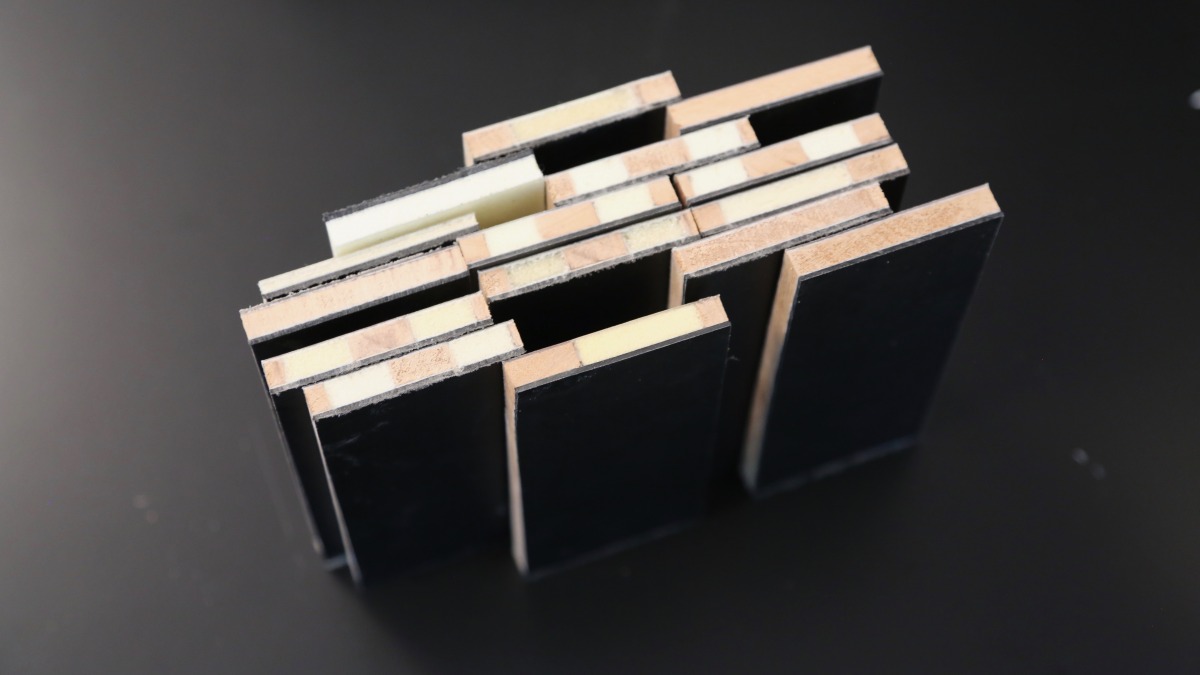
WNDR played with a bunch of test cores to understand the characteristics of the algae composite. Final core composition can be seen in the lead photo.
The Intention 110 is offered in four different lengths — 171cm – 192cm in 7cm increments. It’s also available in two camber profiles — rocker/camber or full rocker. I was able to put about 10 days on a 178 Intention 110 cambered model early this season. With a healthy amount of tip and tail rocker, the 178 was a bit too short for me at first. I moved the mount back -1 cm and skied it with the two-buckle La Sportiva Skorpius which resulted in a great below treeline powder setup — mostly what we ski in an early season Colorado snowpack. The 178cm Intention 110 weighs in around 1750 grams, not the most feathery ski out there, but light for its width and dampness.
The Intention is a very descent oriented lighter ski, as to be expected from the team heading up the WNDR brand. Matt Sterbenz, former pro and founder and ski designer of 4FRNT skis is the GM of winter sports at Checkerspot. They recently added pro shredder Pep Fujas as a VP of Marketing and Product Development for the WNDR brand. The team has created a playful and damp ski that can hold its own in variable snow. I took the Intention up on the ski resort to check out its firm snow performance. Before long, I was railing high speed Super G turns in the variable man-made conditions with confidence. The algae composite does an excellent job at capturing vibrations, leading to a damp, alpine ski feel.
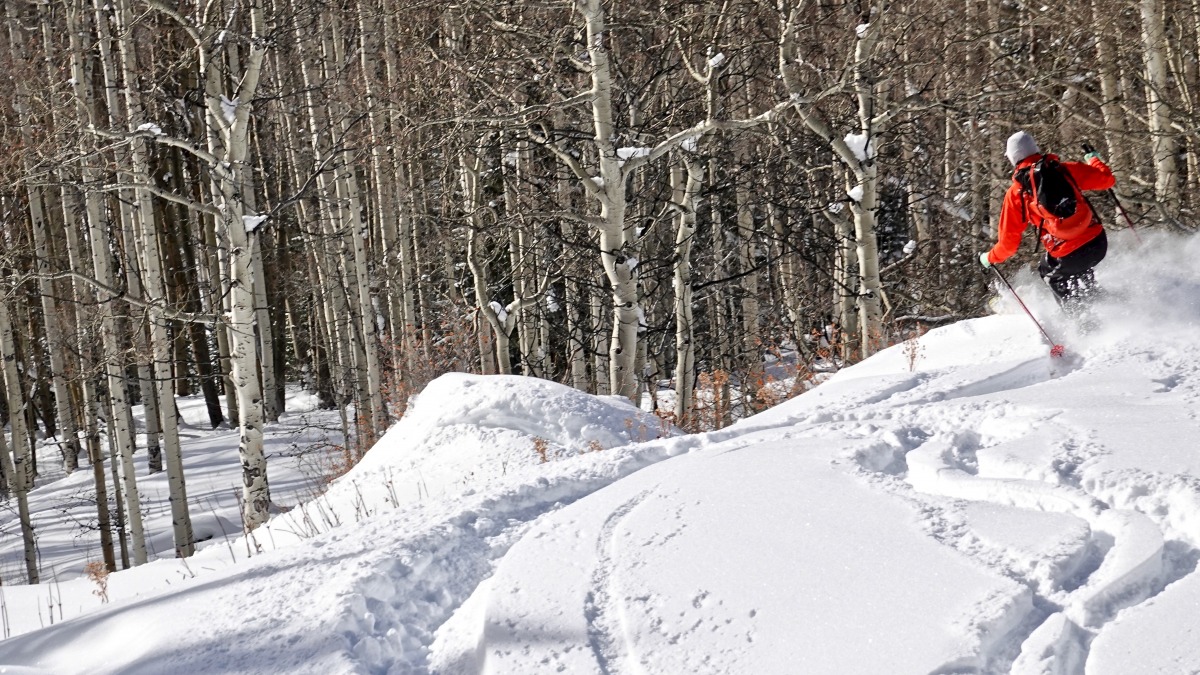
Lapping lumpy low angle powder early season. The 178 Intention 110 really excelled in pillowy terrain and tree skiing.
In backcountry powder, I found the cambered Intention 110 to be lively when needed, whipping quick turns around tight trees. The ski was responsive, yet able to modulate depending on how hard it was pressured. I think the 185cm reverse camber model would be my model of choice after testing the 178cm camber model. The reverse camber shaping would retain some that maneuverability while the extra 7cms would allow for higher speeds and opening up the turn shape.
Since the Intention’s original release, WNDR has been able to create Polyurethane sidewalls using algae. The semi capped sidewalls on the current ski are standard petrol-based ABS plastic. All future WNDR models will wet pour algal PU into routed channels around the core. This allows the eco friendly PU to bond directly to the wood core without additional adhesives, yielding lower weight, lower waste, better longevity, and better ski performance. Roughly the same algae are modified and refined to make the ultralight vibration dampening foam in the core, as well as the hard plastic PU sidewall. Really cool stuff.
The WNDR team is looking at new shapes and widths as well. Recently, Fujas was testing a 120mm waisted powder board in Japan. There is also a 100mm waisted ski coming down the pipeline. I hope to see the core composition trend a bit more towards algal foam and paulownia in the 100, in an effort to create a damp sub 1500 gram ski. I would also like to see the cambered 100, and all widths for that matter, made with less tail rocker. With a full reverse option available, the cambered line’s double-rocker profile doesn’t seem to differentiate enough to suit firm snow and ski mountaineering applications better, as well as skiers who prefer a traditional tail.
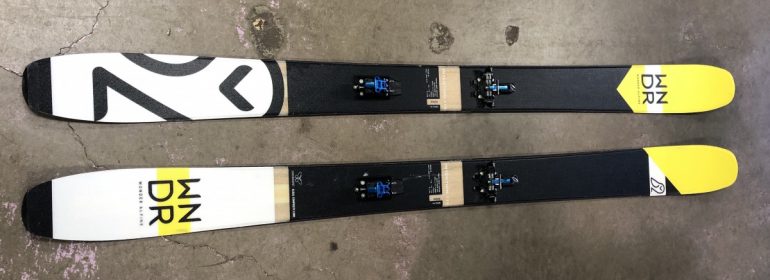
The tester setup proved to be fun and surfy, but also damp.
Checkerspot’s team of PhD scientists in their Berkley laboratory are not supported by some passionate skiers building and selling planks in Salt Lake. Furthermore, they are not delusional thinking that they can change the world by making skis with algae, but do think their materials can be utilized across many industries. This is indeed an eco-friendly materials company with a chance to make a real global impact, that happens to own a ski brand. That’s not to say that the skiers of the company won’t try to lead by example.
According to Fujas, “We press our skis using recycled resin made with the byproducts of other industrially important processes, ship using custom sized boxes with repulpable tape, wrap our skis in recycled paper instead of plastic, and ship UPS Carbon Neutral. We’re definitely not perfect out of the gate, but you’ll be seeing a lot more from us as we increase biobased content and divert waste from the landfill, all while increasing product performance.” Hats off to this practical approach to building great skis with environmental integrity.
SPECS
Weight: 1750g/178cm, 1800g/185cm, 1900g/192cm
Available sizes: 171cm, 178cm, 185cm, 192cm
Dimensions: 136-110-128mm
Profile: Rocker-Camber-Rocker or Reverse Camber
Core Construction: Aspen, Paulownia, Checkerspot™ Algal Composite
Available to purchase only direct at wndr-alpine.com
On March 22nd 2021, Gary Smith tragically died in an avalanche outside of Beaver Creek Resort in Colorado. Since 2018, Gary has been a frequent and insightful contributor to WildSnow. From Christmas Eve spent at the Wildsnow Field HQ cabin, to testing gear and sharing his love for steep skiing around the world, he was a pillar of the ski touring community and will be greatly missed.

